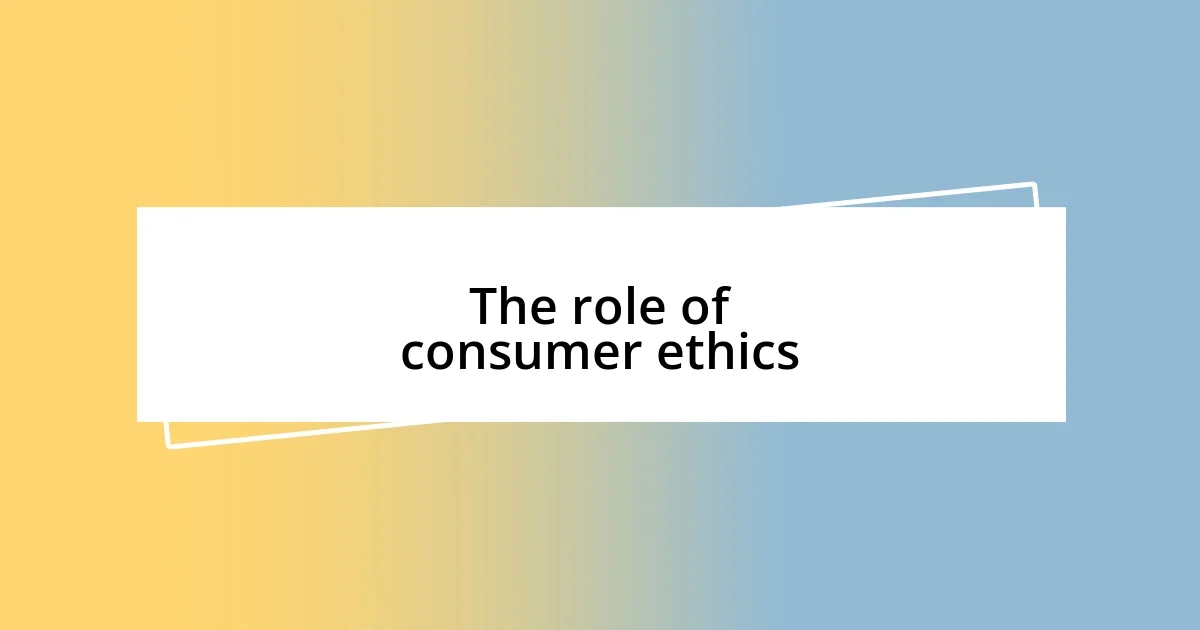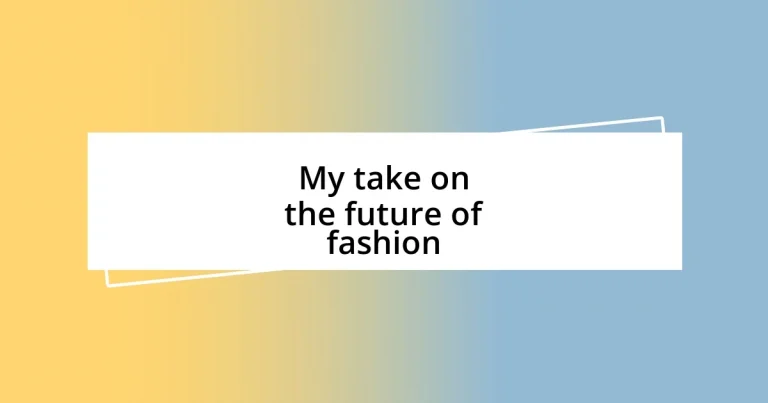Key takeaways:
- Emphasis on sustainability is growing, with a shift towards innovative materials, ethical production, and timeless designs in fashion.
- The integration of technology, including AI and augmented reality, is transforming the shopping experience and design processes while raising questions about personal touch and physical interactions.
- Consumer ethics and the concept of slow fashion are gaining traction, encouraging consumers to demand transparency and make mindful purchasing decisions that align with their values.

Future trends in fashion
As I look ahead in the fashion world, I can’t help but feel excited about the growing emphasis on sustainability. I remember my first encounter with a sustainable brand; the clothes were not only chic but also made from recycled materials. It shocked me to realize fashion could align with environmental responsibility, and I often wonder how many people truly understand the positive impact their choices can have.
Another trend I foresee is the rise of technology in fashion, particularly through the use of augmented reality. Picture this: trying on clothes virtually without ever stepping foot in a store. I had a taste of this when I used an app that allowed me to see how a dress would look on me from my living room. It was surreal! But this leads me to ask—will this technology enhance our shopping experience or rob us of the thrill of trying on clothes in person?
Lastly, I’ve noticed a shift towards inclusivity and diversity in fashion, which resonates deeply with me. Attending a recent fashion event, I marveled at the varied body types and cultural backgrounds on the runway. It made me reflect: why should fashion be one-size-fits-all? The industry’s progress in embracing individuality gives me hope for a future where everyone feels represented.

Impact of technology on fashion
The fusion of technology and fashion is reshaping how we experience and interact with clothing. For instance, when I first encountered 3D printing in fashion, it amazed me to see how designers could create intricate pieces that were once impossible to manufacture. I had the chance to wear a pair of custom-printed shoes, and it was enlightening to realize they were tailored to my feet—something that not only boosted my confidence but also sparked a conversation about the future of custom fashion.
Moreover, the intersection of data and personal styling is something I find fascinating. With brands harnessing artificial intelligence to curate outfits based on our social media preferences, I couldn’t help but feel a mix of excitement and apprehension. Recently, I used an AI-driven app that suggested outfits tailored to my style. While it made shopping easier, I pondered—are we losing the personal touch that comes from the human aspect of styling?
As we embrace these technological advancements, there’s also the rise of virtual fashion shows that breaks geographical barriers. I recall tuning into a live-streamed fashion event from my apartment, watching designers showcase their collections in stunning digital environments. It was engaging yet made me question the future of physical runway shows. Will this shift lead to a more connected global fashion community, or is it a step towards losing the palpable energy of live events?
| Technology | Impact on Fashion |
|---|---|
| 3D Printing | Customizable and intricate designs, leading to personalized fashion experiences. |
| Artificial Intelligence | Data-driven styling recommendations, enhancing convenience but risking personal touch. |
| Virtual Fashion Shows | Increased accessibility and global reach, potentially overshadowing traditional runway experiences. |

Sustainability in fashion design
Sustainability in fashion design is a concept I find increasingly compelling. Reflecting on a conversation I had with an emerging designer, I was struck by her commitment to using organic fabrics and low-impact dyes. It reminded me of my own journey towards a more sustainable wardrobe, beginning with the simple act of choosing second-hand items that tell a story. The emotional connection I feel to these pieces, knowing they’re helping reduce waste, adds layers of meaning beyond just fashion.
- Innovative Materials: Many designers are now exploring alternatives like mushroom leather and recycled plastics, which challenge traditional notions of luxury.
- Ethical Production: The shift towards transparent supply chains resonates with my values, as I appreciate brands that prioritize fair labor practices.
- Timeless Designs: I see brands moving away from fast fashion cycles to create timeless pieces, which often feel more personal and thoughtful.
When I recently attended a sustainable fashion workshop, I felt a surge of hope as I saw participants eager to learn about eco-friendly practices. It was a vivid reminder that sustainability isn’t just a trend—it’s becoming an integral part of our lives, and I’m thrilled to see where this journey leads us all in the world of fashion.

The role of consumer ethics
Consumer ethics are becoming increasingly pivotal in fashion, shaping how brands operate and how we, as individuals, engage with what we wear. I remember a time when I stumbled upon a label that not only produced stylish clothing but also shared detailed information about their production practices. It left me feeling empowered to align my purchases with my values. Does knowing that my favorite shirt was made in a fair working environment influence my buying decisions? Absolutely.
As consumers, I believe we hold the power to demand more transparency from companies. My friend recently shared her experience of confronting a brand about their sourcing methods, and to my surprise, they responded positively by committing to more ethical practices. This stirred in me the realization that our voices matter. So, what role do we want to play in shaping the future of fashion? I see us as advocates, pushing for change through every purchase we make.
Additionally, I find it interesting how the concept of slow fashion is gaining traction among conscious consumers. After trying a capsule wardrobe approach—curating a smaller selection of versatile pieces—I found myself more mindful about every item I added. I’ve noticed that when I invest in quality pieces rather than fast trends, I not only feel better but also contribute positively to a more sustainable fashion landscape. Who knew that choosing carefully could also feel like a personal victory?

Digital fashion and virtual experiences
Digital fashion is not just a fad—it’s a fascinating convergence of technology and creativity that I believe will redefine how we experience style. Recently, while scrolling through a virtual fashion show, I was struck by the idea of wearing digital garments in online spaces. I found myself asking: How does an outfit that exists only in cyberspace influence my identity? The answer became clear—I felt empowered to express myself in entirely new ways, unburdened by the constraints of physical materials.
Virtual experiences are transforming the shopping landscape. I remember trying on a stunning digital dress via augmented reality for an upcoming online event. The technology was so seamless that I felt an exhilarating spark of excitement, as if I was selecting my outfit in a physical store. Suddenly, the act of getting dressed became not only about aesthetics but also about creativity and self-expression. Isn’t it fascinating how digital platforms allow us to explore fashion without boundaries, helping us to visualize looks and styles we may have never considered?
As I explore these new digital avenues, I can’t help but reflect on the environmental implications. Imagine the reduction in textile waste if we embrace virtual fashion wholeheartedly! During a recent discussion with a friend about this topic, we pondered: Could the future of fashion coexist with our commitment to sustainability? I believe it can, as we redefine how we see beauty and innovation through the limitless canvas of the digital realm.

Integration of AI in fashion
The integration of AI in fashion is truly reshaping the industry in ways I never imagined possible. I once had the chance to experiment with a fashion app that used AI to create personalized outfit recommendations based on my existing wardrobe. It felt almost like having a digital stylist at my fingertips, truly understanding my preferences and helping me discover fresh combinations I hadn’t considered. How neat is it to think that technology can enhance our personal style journeys?
AI is not just about convenience; it’s revolutionizing the design process itself. I recall reading about a designer who collaborated with an AI tool to analyze trends and generate innovative patterns. The result? A stunning collection that blended human creativity with cutting-edge technology. It made me wonder: moving forward, will we see a more collaborative relationship between designers and machines? I believe this fusion might just unleash untapped creativity in the fashion world.
Additionally, AI’s role in inventory management is a game changer that resonates with my thoughts on sustainability. I recently learned how brands are using AI to predict consumer demand more accurately, thereby reducing overproduction and waste. This advancement aligns perfectly with my passion for sustainable fashion. Isn’t it exciting to consider how intelligent systems can contribute to a healthier planet while keeping our closets stylish? I genuinely see AI as a partner in crafting a more responsible future for fashion.

Strategies for adapting to changes
Adapting to changes in fashion demands an open mind and a willingness to embrace new technologies. I remember feeling overwhelmed at the thought of virtual fitting rooms when they first emerged. However, after trying one out, my perspective shifted entirely. The ability to see how garments fit without leaving my home transformed my shopping experience, making me realize that being adaptable is not just a trend but a vital skill for navigating this evolving landscape.
Collaboration will also play a crucial role in adaptation. Recently, I attended an online workshop where fashion designers teamed up with tech innovators to brainstorm new ways to enhance sustainability. The energy in the virtual room was palpable as we exchanged ideas about upcycling innovations and digital fabrications. It hit me that by fostering partnerships across different disciplines, we can create solutions that address environmental concerns while elevating style. Have you ever considered how collaboration might lead to breakthroughs in your own life?
Furthermore, staying informed about emerging trends is essential for everyone in the fashion world, from consumers to industry professionals. I’ve found that subscribing to fashion-tech newsletters keeps me in the loop about the latest tools and strategies. Just the other day, I stumbled upon an article discussing biodegradable materials being explored in fashion. As I read through the possibilities, I felt excitement building within me, knowing that every effort counts in paving the way for a more conscientious future. In this fast-paced world, isn’t it empowering to understand that our ability to adapt shapes the future of fashion?














